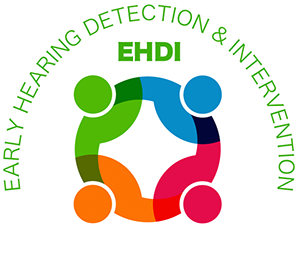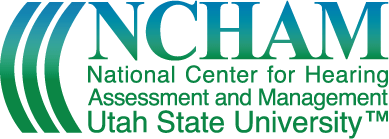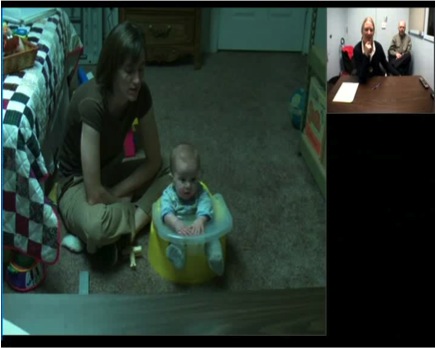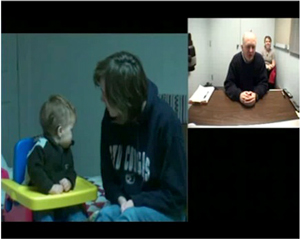Last Modified: 06/23/2023
III. Training and Implementation of Tele-Intervention Sessions

It is critical that TI provides high-quality services in keeping with recommended family-centered early intervention practices. The TI 101 Training Courses is a recommended resource for those seeking to understand key components to implementing TI. These free courses contain real-life scenarios, video clips, and implementation tools for:
- EI direct service providers
- Families interested in TI
- Administrators
Additionally, the American Speech, Language, Hearing Association (ASHA) has published Telepractice Service Delivery Regulations. A series of documents for speech/language pathologists and audiologists is available at: Telepractice for SLPs and Audiologists.
A good tele-intervention session should look the same as a high-quality traditional home visit. Recommended practices for both TI and traditional home visits include the use of coaching strategies, routines-based interventions, and naturalistic teaching opportunities. The table below summarizes key “best practice principles” that apply to TI (JCIH, 2007; NECTAC, 2008). These four principles are consistent with best practices in early intervention in general and best practices promoting the development of communication in infants and toddlers who are DHH. More detail can be accessed by reviewing the document published by the Joint Committee on Infant Hearing and the document from the Early Childhood Technical Assistance Center.
On This Page
- Early Intervention Principles Guiding Tele-Intervention
- Meeting Requirements of Natural Environments
- Skills and Training of a TI Provider
- Mentoring and coaching of TI providers
- Skills of a Caregiver Receiving TI
- Preparing for TI Session
- Getting the Technology Ready for a TI Session
- Conducting the TI Session
- Caseload Considerations for TI providers
- Monitoring Child Development & Audiological Functioning Via TI
- Meeting Requirements of Natural Environments
Early Intervention Principles Guiding Tele-Intervention
| Best Practice Principles | Key Elements |
|---|---|
| Communication-focused intervention provided by early intervention providers with skills working with infants and toddlers who are DHH |
|
| Intervention is provided in natural environments to promote family-centered services |
|
| Full-time use of appropriately fit hearing technology |
|
| Ongoing developmental assessments |
|
Meeting Requirements of Natural Environments
Natural environments are defined in the Individuals with Disabilities Education Act (IDEA, 2004) as services provided in the home and in community settings in which children without disabilities participate – meaning in settings that are natural or normal for children in general.The provision of EI services in natural environments is required under IDEA, yet other references provide valuable insight to fully understand the definition and components of natural environments. According to an OSEP-supported workgroup on natural environments, there are seven principles that demonstrate how the definition of natural environments goes beyond physical setting or location alone. Rather, it involves use of learning activities that are functional, based on the child and family routines; engaging caregivers as essential partners while incorporating family strengths and providing supports to highlight a few of the elements.
Given this richer definition of natural environments, TI is consistent with ensuring natural environment requirements. For example, the strong use of coaching strategies within TI is in direct support of natural environments involving a focus on the family by building on their strengths, increasing the ability to foster their child’s development, and using everyday routines as the basis of TI activities.
To date, the learning community members have not been challenged by Part C administration questioning TI as conflicting with natural environments. This is most likely due to the TI programs providing thorough descriptions of this mode of service delivery when communicating with Part C policy makers along with input from families about how TI has enhanced their lives and their child’s development.
Tele-intervention has been reported to not only support use of natural environments, but also to support many of the 14 IDEA Part C indicators that require state reporting. This information is important to share with Part C administration to demonstrate how providing TI can actually help meet state requirements.
Skills and Training of a TI Provider
As with the development and application of any new service delivery method, it is important that providers who are about to embark on implementing tele-intervention are provided with training and support. For many providers, delivering services via the internet can be intimidating. Additionally, research has shown that providers do not demonstrate the use of coaching strategies that is recommended as best practice (Campbell & Sawyer, 2007). Training, technical assistance, and coaching of the providers implementing TI must occur in a supportive, consistent, and continuous manner. Here are some important resources:
- The "Skills Checklist for Providers of Tele-Intervention" provides an overview of skills.
- The free, self-study TI 101 course for providers provides more in-depth, comprehensive information pertaining to training and support recommended for TI providers.
- Download a ppt presentation from an initial group training session conducted by members from one of the learning community programs [PPT]
Mentoring and coaching of TI providers
In addition to formal training, EI providers can benefit from the following:
- Direct observation of TI sessions: observing live sessions as well as recorded sessions.
- Provider- to- provider live practice using equipment.
- Experienced provider mentors provider during first TI session: preparation for session, set up, and implementation of the session.
- Experienced provider provides feedback to provider.
- Intermittent group training sessions continue, focusing on trouble-shooting, improving skill set.
A Skills Checklist for Providers of Tele-Intervention
- Has basic knowledge of computers and other equipment that is being used
- Can trouble-shoot video and audio equipment
- Attends to technology while conducting the session
- Organizes materials for activities ahead of time based on naturally-occurring routines
- Conducts activities that involve materials and actions that are easily depicted over video/audio
- Together with the caregiver, plan a variety of activities planned in case some are not successful
- Can adjust activities based on immediate interests of child/family
- Demonstrates use of coaching techniques when working with family members/caregivers
Learning community members have conducted training via the following activities. Although the effectiveness of these trainings has yet to be scientifically evaluated, they serve as a starting point:
- Group training session re: tele-intervention: defining tele-intervention; benefits & challenges, overview of TI sessions;
- Group training re: effective coaching strategies for use during TI sessions.
- Direct observation of TI sessions: observing live sessions as well as recorded sessions.
- Provider- to- provider live practice using equipment.
- Experienced provider mentors provider during first TI session: preparation for session, set up, and implementation of the session.
- Experienced provider provides feedback to provider.
- Intermittent group training sessions continue, focusing on trouble-shooting, improving skill set.
Skills of a Caregiver Receiving TI
Caregivers –typically family members - also need a skill set for participating in TI. This skill set is built on the partnership and coaching received by all recipients of family-centered intervention. In TI, as in any high-quality EI session, the emphasis is on family members as active participants and the primary “teacher” for their child.
The free online TI 101 course is useful for new families about to embark on TI.
A Skills Checklist for a Family Receiving Tele-Intervention
- Has a basic comfort level with computers and a willingness to learn new technologies
- Identifies activities, strategies, learning opportunities, and practices that will enhance their child’s learning and communication development
- Knows how to prepare the home environment for an optimal TI session
- Demonstrates strategies that are modeled and discussed during the session
- Makes decisions regarding which strategies and activities work best for their child/family
- Reflects on the TI sessions
- Implements strategies that work and revises the strategy when it does not have the desired outcome
Preparing for TI Session
Creating a Listening Environment
It is important to ensure that the home environment as well as the interventionist’s setting supports optimal listening, which includes limiting distractions. As noted in the Technology and Home Environment Tele-Intervention Checklist, it is important to omit background noises, such as TV’s, radios, and phones. The caregiver should make sure that the child’s hearing devices are in place and working.
Featured Articles
- Telepractice Training for Early Intervention with Children who are Deaf/Hard-of-Hearing [PDF]
- Provider Perspectives on Telepractice for Service Families of Children Who Are Deaf or Hard of Hearing [PDF]
- Provider Perspectives on Telepractice for Service Families of Children Who Are Deaf or Hard of Hearing [PDF]
- A New Approach to Early Intervention: Virtual Home Visits [PDF]

Management of Others in the Environment
Both interventionists and families should ensure that others in the home or work environment know when the TI sessions are scheduled and understand the importance of not interrupting. Posting a “Do not disturb” sign sends a clear message, but establishing clear rules about waiting until the session is over is the most practical approach.
Selecting TI Materials
In accordance with natural environments, instructional materials used in TI are similar to those used in any effective early intervention situation—materials that are part of the child and family’s everyday routines and that are culturally and developmentally appropriate. To facilitate best use of the TI session, interventionists and the family should plan together to identify instructional, everyday materials that the family needs prior to each session, asking the caregiver to be ready with these materials. Due to the use of a computer screen to demonstrate activities for the caregiver, the interventionist doing TI may find it useful to select materials that are larger and more visible over the computer screen, such as picture books. Additionally, a document reader can be used by the interventionist to enlarge the materials, including picture books (see Section IV, Technology, for information on document readers). However, as in any high-quality home visit, it’s important for the intereventionist to move from demonstrations to observing and coaching the caregiver as the primary intervenor with their child.
Getting the Technology Ready for a TI Session
Prior to beginning TI services, it is important to determine the extent to which the family’s home has an adequate internet connection and computer equipment. The "Checklist for Determining Home Capacity for Tele-Intervention" [DOCX] provides a way to record this fundamental information which can then guide the provider in determining if additional internet capacity and equipment are needed.
Preparing for a TI session requires planning and organization. However, this effort is typically out-weighed by the amount of travel time that is being saved. The Technology and Home Environment Checklist can be used by families and providers to assure the technology is ready for a smooth TI session.
Technology and Home Environment Tele-Intervention Checklist
At least 15 minutes prior to your scheduled session, prepare the environment, the equipment, and the connection as follows:
Prepare Your Environment
- Choose an optimal room in your home based on the planned activity
- Make sure there isn’t glare coming from uncovered windows/doors
- Have provider-requested materials for the activity available
- Remove other items/toys that may be distracting
- Mute phones that may interrupt
- Turn off TV’s, radios, other auditory/visual distractions
- Test hearing devices (i.e., ensure batteries are working, have spare batteries available)
- Change child’s diaper/take to the toilet
- If necessary, feed child before session
- Identify the exact time the session will begin and end
- Post “Do not disturb signs”, if needed
Prepare Your Equipment and Connection
- Make sure a power strip is on and/or the plug is secure
- Turn on the computer
- Make sure the camera and microphone are connected and working
- Have headphones available to help eliminate the echo effect
- Log off of any other programs/windows that are open on the computer
- Log onto the program being used using your username and password—Consider posting it by the computer in a discrete location
- Run the “test” feature, if available
- If recording the session via a third- party software program, start the program and test as necessary
- Make sure other computers in the house are turned off as other traffic will reduce bandwidth and limit the quality of the internet connection
- Have a cell phone number for the provider available if an internet connection cannot be made
Ending the Session
- Discuss any problems with the connection
- Determine the date and time of the next session
- “Hang up” and close down the program site
- Close down the recording site
- Notify others in your household that you have ended the session
Conducting the TI Session
The learning community members typically conducted 1-hour sessions. The actual TI session can be divided into 3 main phases:
- Reviewing goals, activities
- Discussion of goals from the previous week
- Update on new communication milestones, new behaviors, sounds, words that have emerged
- Review of goals for current session
- Audiological check of hearing devices
- Conducting the lesson/activity
- Demonstration of new or ongoing strategies, techniques with appropriate activities
- Coaching the parent as he/she performs the activity
- Discussion of integration of goals into the daily routines of the home
- Debriefing
- Allowing questions from the parents about next steps, goals, short- and long-term outcomes
- Discussion of continuation of goals or selection of new goals based on present performance. Documents can be shown through the camera, document readers or “share document” on screen to allow parents to see the actual developmental scale, charts, handouts, etc.
- Summarizing of the session and goals for the coming week. Providing follow up progress notes. This can be done by filling in a template and emailing, scanning interventionist notes and emailing or mailing a hard copy of notes.
An interventionist from Sound Beginnings, one of the participating learning community programs, has provided detailed information based on the following phases of a typical session (Edwards, 2011; Sound Beginnings Program, Utah State University):
An Overview of a Tele-Intervention Session
Preparing for the Session
- Email/call the family the day before to confirm the session
- Assure that the parent has the home environment and equipment ready
- Have the child situated comfortably (e.g., high chair, small chair, floor)
- Prepare your equipment and establish the connection; 15 minutes before the session review “Technology and Home Environment TI Session Checklist”
- Provider and family should have cell phones handy in case of technological difficulties
The Session
- Record the session, if intended
- Allow for 1-2 second time lag in audio transmission.
- Ask parent if audio and visual connection is adequate
- Discuss any questions or problems with hearing technology (e.g., hearing aid, FM, cochlear implant)
- Review the goals and outcomes from the previous week
- Review the child’s progress on tasks covered the previous week
- Discuss goals for the current session
- Explain how you intend to model an activity; explain when you expect the parent to take over
- Clearly communicate the goal of each activity
- “Hand” the activity over to the parent
- Provide feedback at strategic times or when the activity has been completed
- Always provide positive feedback
Reflection and Feedback
- Review the jointly determined goals for the session
- Make recommendations for parent follow-up
- Schedule the next session
- Discuss problems with the connection (e.g., audio and visual transmission)
- Assure that you are no longer logged on to connection!!!
Follow-Up After the Session
- Email/mail the following information to the family:
- Summary of session recommendations
- Any additional Information on other topics discussed, such as parent support and coaching
- Any new materials for future sessions
- Date of the next session
Caseload Considerations for TI providers
Although TI can reduce travel time for providers, this does not necessarily mean that an EI provider’s caseload can be increased if they’re implementing TI. In fact, providers may need more time for planning and conducting intervention sessions for each family since TI often results in fewer cancellations and thus more sessions being conducted. Conducting TI sessions also requires the provider to attend to technology while maintaining appropriate interpersonal interactions. As a result, EI providers also benefit from time to "reflect and decompress" after TI sessions. It is the learning community’s recommendation that programs make any adjustments to caseloads based on EI provider experiences and collaborative decisions after some time in implementing TI.
Monitoring Child Development & Audiological Functioning Via TI
Monitoring child developmental progress, particularly in regard to language, is an important component of early intervention. Tele-intervention lends itself to evaluating child performance using observation scales and language samples via a variety of ways. An objective observer or a team member can be present though “off screen”, providing the opportunity to monitor development without potentially impacting the interaction occurring during the session. Additionally, recordings of the sessions also can be used to evaluate child performance using observation scales or to code language samples. These recordings also lend themselves to inter-rater reliability checks to ensure accuracy of coding.
TI provides an opportunity to have the audiologist join the TI session to monitor the child’s hearing development, including hearing aid use, cochlear implants, and other devices without requiring the family to come to the center. TI allows the caregiver and the interventionist to consult with the audiologist and address concerns as they arise. Audiological services still require clinical evaluations to occur in sound booths and direct use of audiological equipment, but the ability to observe the child’s behavior in a natural setting via TI is valuable.
Standardized tests require strict adherence to the conditions mandated by the test manual. For most standardized tests, this means that administration is limited to traditional face-to-face contacts. Therefore, such testing is typically conducted during a complementary traditional home visit or when the family travels to the early intervention center or clinic. Section VII, Evaluating Tele-Intervention Outcomes, contains additional information regarding evaluation tools for monitoring child development as well as other key constructs.
Meeting Requirements of Natural Environments
Natural environments are defined in the Individuals with Disabilities Education Act (IDEA, 2004) as services provided in the home and in community settings in which children without disabilities participate – meaning in settings that are natural or normal for children in general.
The provision of EI services in natural environments is required under IDEA, yet other references provide valuable insight to fully understand the definition and components of natural environments. According to an OSEP-supported workgroup on natural environments, there are seven principles that demonstrate how the definition of natural environments goes beyond physical setting or location alone. Rather, it involves use of learning activities that are functional, based on the child and family routines; engaging caregivers as essential partners while incorporating family strengths and providing supports to highlight a few of the elements.
Given this richer definition of natural environments, TI is not inconsistent with meeting natural environment requirements. For example, the strong use of coaching strategies within TI is in direct support of natural environments involving a focus on the family by building on their strengths, increasing the ability to foster their child’s development, and using everyday routines as the basis of TI activities.
To date, the learning community members have not been challenged by Part C administration questioning TI as conflicting with natural environments. This is most likely due to the TI programs providing thorough descriptions of this mode of service delivery when communicating with Part C policy makers along with input from families about how TI has enhanced their lives and their child’s development.
Tele-intervention has been reported to not only support use of natural environments, but also to support many of the 14 IDEA Part C indicators that require state reporting. This information is important to share with Part C administration to demonstrate how providing TI can actually help meet state requirements.





